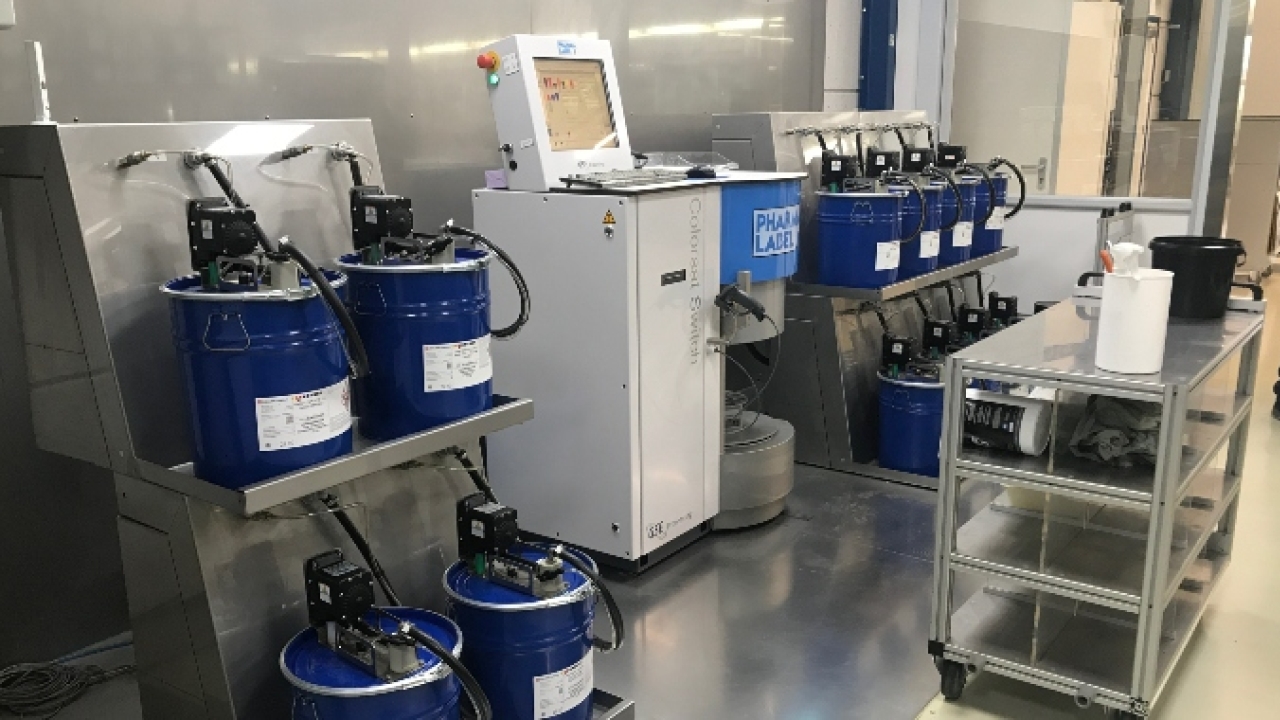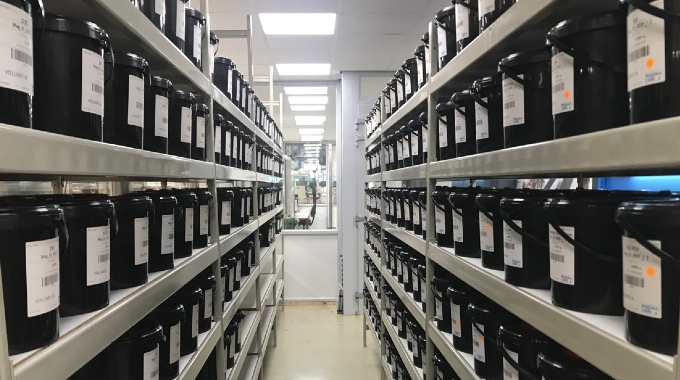Automated ink logistics

Thriving in a service-oriented environment where the ability to assure repeatable quality is a given requires a culture-change, not a cost-cutting exercise, that comes in two stages. The first is to adopt the ‘lean’ mindset of waste elimination and continual improvement; the second is to become ‘smart’ by exploiting software advances and the internet to accelerate processes and make better, faster decisions.
“‘Lean’ is a way of collective thinking to methodically stamp out waste while simultaneously maximizing value creation”
Lean – as neatly defined by business coach Andy Brophy – is a way of collective thinking to methodically stamp out waste while simultaneously maximizing value creation. People are at the heart of this transformation: employees be motivated to performing their work better every day, thinking deeply about it to understand the shortfalls and develop improved methods.
Lean delivers a strong competitive advantage because the changes it brings directly improve the bottom line. According to management consultants McKinsey & Company, EBITDA margins in the packaging sector are about 10 percent. Imagine a year’s savings of 100,000 EUR because of a Lean waste reduction program: this is equivalent to improving turnover by more than 1 million USD – and even that assumes the extra revenue is generated 100 percent waste-free.
Overhauling ink-related processes is a good place to start your company’s Lean journey. First, ink takes a complex journey through the printing house with costly consequences when mistakes happen. Second, because color accuracy is critical for doing business with brands, there is literally no time or space for mistakes or remakes, especially when delivering short runs ‘just in time’.
For all the concern about ink price hikes in the first quarter 2021, brought on by global supply chain difficulties, the price is the tip of a large cost iceberg, with indirect costs of managing, processing, production, shipping and – for some sectors – batch tracing, hidden under the waterline, and only revealed by failures in your system. Examples are scrap resulting from printing an inaccurate color, an idle press waiting for a color shade to arrive, or, at worst, a product recall.
The lean and smart ink logistics program
A tailored Lean ink logistics program starts with understanding what customers value – what they are willing to paying for. They may want labels and packaging but these are a means to an end: increased sales, or compelling, identifiable and consistent point-of-sale branding, for instance.
The trick is to look at the processes and identify which costs provide value, and to reduce as much as possible the costs and tasks that do not end up providing value.
We understand waste to be the use of any excessive time, materials, tools, techniques, people and space in order to offer added value to the customer.
There are eight types of waste – and they relate to ink in label converting as follows:
- Overproduction: producing more ink or labels than the customer will pay for.
- Inventory: stockholding costs rise without effective management – overstuffed stocks, cluttered with returned inks that are out of date; colors running out of stock.
- Waiting: job change-over times become a greater threat to profitability in an age of shorter production runs. Imagine a high-performance press standing idle because of delays mixing an ink recipe.
- Transport: the cost of shipments. It is cheaper to buy base inks in large containers rather than multiple small-volume orders.
- Motion: the cost of internally handling and moving inks within the factory – excessive walking.
- Over-processing: administrative costs of purchasing, storing, monitoring, providing or relying on unnecessary services such as ink mixing by the supplier.
- Rework/rejects: the cost of not meeting quality expectations in terms of wasted materials, manpower, downtime and production time.
- Human talent: excessive manual intervention – from administration to manually mixing inks – means that employees are less likely to fulfil their productive or creative potential.
Workplace reorganization with the 5S Program
Reorganization of the workplace is necessary, to create the conditions that enable waste to be eliminated or problems to be resolved as soon as they occur. Implementing what is known as the ‘5S Program’ results in pristine premises that a customer would find a pleasure to tour, and is the basis for ‘pit-stop’ conditions in which makeready is just a matter of minutes.
The five elements are:
- Sort: remove all items in the ink room that are not used in the work area.
- Set in order: arrange all items so they can be found when needed within 30 seconds. Clean buckets for ink, rolls of labelstock, ink stocks should all be in their assigned places for easy, fast retrieval. Items most often used should be the most accessible.
- Shine: clean and inspect tools, equipment and surfaces, to discover problems as soon as they arise. Regular cleaning of ink chambers or containers will identify leakage and damage. Clean the equipment at the end of every shift and clean ink room thoroughly each week.
- Standardize: make an organized workplace an expectation. This requires leadership and clear communication with the workforce, to set best practice standards, so that everyone knows their responsibilities and appreciates the importance of meeting them.
- Sustain: once the previous four ‘S’ procedures have been established, they must become habits. To prevent any ‘backsliding’ or gradual decline to the old ways, conduct regular audits to ensure continuous improvement, and create a culture of constantly looking for improvements.
The automated ink kitchen
The solution for eliminating ink-related waste and achieving color on demand is a dispensing system, spectrophotometric color measurement and, for flexo process users, tabletop proofing.
Ink dispensing performs the preparation of special color shades, eliminating the need to buy ready-mixed colors from the ink supplier. The dispenser doses the exact ink quality and volume, by calculating and mixing the recipe from barrels of base components. The operator enters the target color and volume requirements into the interface; a computer calculates dosage volumes and activates the process. A batch can be prepared from a number of base colors in just minutes.
Typically, the dispenser comes with software to formulate the recipe, and store it for instant recall, when the job is repeated, and to handle inks returned from the press – booking them methodically into storage and calculating them into new recipes. The recipe software uses digital color data as targets that are typically generated when measuring color by a photospectrometer.

Tailored dispensing systems are available for all label and packaging applications. They are modular in design, so any number of base components can be specified or added later, for example for managing two ink sets. For solvent inks they may be specified with safe grounding devices.
A tabletop wet-proofing system measures a flexo ink’s color at the same dot gain as it will experience on the press. This provides precise color predictability, without fingerprinting, and without the need for color adjustments during job changes at the target press. Without spending money on a new press, an ink proofing system normally adds thousands of euros of new press time to an average flexo plant.
Installing these three pieces of equipment, the process of making and measuring color is automated and accelerated, resulting in a number of benefits: standardized processes for color measurement, dispensing and proofing provide assurance of predictable, repeatable quality, with colors prepared faster and accurately; reduced ink usage – dispense exactly what is needed, instead of ordering more expensive ready-mixed ink or excess inks from the supplier ‘just in case’; reduced ink waste – press-return inks easily reused in new computer-generated ink recipes for new jobs; organized ink stocks make it easy to locate and retrieve press return-inks for reuse; ordering base inks less frequently and mixing your own inks saves transport, warehousing and administration costs; reduced material waste – especially in the start-up phase; faster color-making process, less prone to delays means potential for increased uptime; processes are faster, the workplace is cleaner – improved use of operator’s time.
Given the advantages listed above, a dispenser can result in ink-related cost reductions of up to 30 percent.
Smart ink logistics: integrate software
More recently, software advances and the arrival of the cloud have brought opportunities for speeding up processes plus better cost savings, stock control and forecasting.
Indeed, these advances have enabled a new era of ‘smart manufacturing’ – a term for digital technologies that ensure transparent, integrated and intelligent production processes. Examples of these technologies are ‘work-on-screen’ applications (replacing paper by digital information), product tracking (digital tracking of products in the work flow), information systems (like enterprise resource planning (ERP), management information systems, press controls) and flexible automation (like robots and automated guiding vehicles).
However, for managing inks, an all-purpose ERP software is insufficient. Existing ERP systems are only good for tracking raw materials that follow a ‘linear’ route through the workflow without being returned to inventory after production. Ink doesn’t always have a linear passage: base inks are mixed into spot colors and the re-use of inks in new jobs is – or should be – a relatively frequent activity, especially for a flexo printer. For label and packaging printers, then, a dedicated software for managing ink in the workflow and feeding back activity-based costing information to ERP is necessary.
A modular software package, GSE Ink manager is a response to that, offering greater connectivity, the capability to store, share and analyze more data, and functionalities that enable greater waste reduction, ingredient traceability, faster decision making and strategic planning. Users can choose the combination of packages to suit their needs, for functions including: managing ‘press return’ inks in focused ways, including ‘clustering’ into one component connected to the dispenser for processing, or reserving for specific jobs; integration with existing ERP software and the cloud; performing color corrections and adjustments; creating new colors on the database, by integrating with color formulation software (this process can be supported with the help of a spectrophotometer); management reporting – providing real-time stock level and consumption information, and per-job ink costs; purchasing – generating purchase advice automatically when base color stocks are low; and ink batch traceability – tracks ingredients through the supply chain by storing ink batch data about every job, including reused return inks.

ROI: quantifying the added value of automated ink logistics
It is possible to calculate the returns delivered by ink dispensing, proofing and software, by subtracting the cost of the investment and its maintenance from the financial gains generated from lower costs (direct and indirect), and uptime increases.
Lower costs of ink, transport, consumption, substrate waste, stocks, and ink containers must be considered. There are also indirect administrative cost reductions.
The ink price rises hitting the industry as this article goes to press in August 2021 leverage the value generated by an ink dispenser that reduces consumption. Consider these examples.
Assume that a label printer, originally using 4,000kg ink a year, reduces consumption by 20 percent, through dispensing exactly what is needed and reusing and recycling returns. Savings: 20 percent of 4,000kg, assuming a price of 17 EUR/kg = 13,600 EUR on a yearly basis.
Before investing in a dispenser, the converter placed purchase orders of ready-mixed colors per print run. A job for eight print positions was 8 x 5kg = 40 kg. By investing in a dispenser, the printer places only one monthly order for all printing requirements (4,000 / 12 = 334 kg), resulting in 12 purchase orders per year instead of 100. Assume that each purchase order will take approximately one hour’s work, costing the business 30 EUR. Overall administrative savings to the business are (100 – 12) x 30 EUR = 2,640 EUR per year.
“A dispenser can result in ink-related cost reductions of up to 30 percent”
The current economic climate and volatile ink prices mean it is vital for label converters to look for improvements in processes, workplace organization and ink consumption.
Automated ink logistics brings enormous benefits, but simplify your existing processes and eliminating waste first, before adopting the ‘smart’ software systems. You need the dispensing and proofing equipment for achieving repeatable, accurate quality in place in order for software to provide useful information. The ‘smart’ element of ink logistics complements the ‘lean’: accelerating decision-making, facilitating the Quick Response Manufacturing that potentially transforms the converter into a preferred partner.
Maarten Hummelen is the marketing director at GSE.
Stay up to date
Subscribe to the free Label News newsletter and receive the latest content every week. We'll never share your email address.

